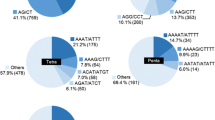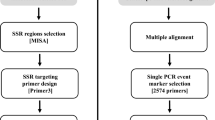Abstract
The objectives of this research were to assess (1) the degree of Simple Sequence Repeats (SSR) DNA length polymorphism in melon (Cucumis melo L.) and other species within the Cucurbitaceae family and (2) the possibility of utilizing SSRs flanking primers from single species to other genera or species of Cucurbitaceae. Five melon (CT/GA) n SSRs were isolated from a genomic library. Two cucumber (Cucumis sativus L.) SSRs were detected through a search of DNA sequence databases, one contained a (CT)8 repeat, the other a (AT)13 repeat. The seven SSRs were used to test a diverse sample of Cucurbitaceae, including 8 melon, 11 cucumber, 5 squash, 1 pumpkin, and 3 watermelon genotypes. Five of the seven SSRs detected length polymorphism among the 8 melon genotypes. PCR amplification revealed between three and five length variants (alleles) for each SSR locus, with gene diversity values ranging from 0.53 to 0.75. Codominant segregation of the alleles among F2 progeny was demonstrated for each of the five SSR loci. Four of the seven SSRs detected polymorphism among the 11 cucumber genotypes, with gene diversity values ranging between 0.18 and 0.64. Primers specific to SSRs of C. melo and C. sativus also amplified DNA extracted from genotypes belonging to other genera of the Cucurbitaceae family.
Similar content being viewed by others
References
Akkaya MS, Bhagwat AA, Cregan PB (1992) Length polyphormisms of simple sequence repeat DNA in soybean. Genetics 132:1131–1139
Akkaya MS, Shoemaker RC, Specht JE, Bhagwat AA, Cregan PB (1995) Integration of simple sequence repeat (SSR) DNA markers into a soybean linkage map. Crop Sci 35: 1439–1445
Beckmann JS, Soller M (1990) Toward a unified approach to genetic mapping of eukarotes based on sequence tagged microsatellite sites. Biotechnology 8:30–32
Beckmann JS, Weber JL (1992) Survey of human and rat microsatellites. Genomics 12:627–631
Bell CJ, Ecker JR (1994) Assignment of 30 microsatellite loci to the linkage map of Arabidopsis. Genomics 19:137–144
Bernatzky R, Tanksley SD (1986) Toward a saturated linkage map in tomato based on isozymes and random cDNA sequences. Genetics 112:887–898
Broun P, Ganal MW, Tanksley SD (1992) Telomeric arrays display high levels of heritable polymorphism among closely related plant varieties. Proc Natl Acad Sci USA 89:1354–1357
Brunel D (1994) A microsatellite marker in Helianthus annuus L. Plant Mol Biol 24:397–400
Condit R, Hubbell SP (1991) Abundance and DNA sequence of two-base repeat regions in tropical tree genomes. Genome 34:66–71
Danin-Poleg Y, Paris HS, Cohen S, Rabinowitch HD, Karchi Z (1996) Oligogenic inheritance of resistance to zucchini yellow mosaic virus in melons. Euphytica (in press)
Davies K (1993) Of mice and men (and cows and cats). Nature 361:478
Dellaporta SL, Wood J, Hicks JB (1983) A plant DNA minipreparation: version II. Plant Mol Biol Rep 1:19–21
Devos KM, Bryan GJ, Collins AJ, Stephenson P, Gale MD (1995) Application of two microsatellite sequences in wheat storage proteins as molecular markers. Theor Appl Genet 90:247–252
Figdore SS, Kennard WC, Song KM, Slocum MK, Osborn TC (1988) Assessment of the degree of restriction fragment length polymorphism in Brassica. Theor Appl Genet 75:833–840
Hamada H, Petrino MG, Kakunaga T (1982) A novel repeated element with Z-DNA-forming potential is widely found in evolutionarily diverse eukaryotic genomes. Proc Natl Acad Sci USA 79:6465–6469
Helentjaris T, King G, Slocum M, Siedenstrang C, Wegman S (1985) Restriction fragment polymorphisms as probes for plant diversity and their development as tools for applied plant breeding. Plant Mol Biol 5:109–118
Kennard WC, Poetter K, Dijkhuizen A, Meglic V, Staub, JE, Havey MJ (1994) Linkages among RFLP, RAPD, isozyme, diseaseresistance, and morphological markers in narrow and wide crosses of cucumber. Theor Appl Genet 89:42–48
Knerr LD, Staub JE (1992) Inheritance and linkage relationships of isozyme loci in cucumber (Cucumis sativus L.). Theor Appl Genet 84:217–224
Knerr LD, Staub JE, Holder DJ, May BP (1989) Genetic diversity in Cucumis sativus L. assessed by variation at 18 allozyme coding loci. Theor Appl Genet 78:119–128
Kresovich S, Szewc-McFadden AK, Bliek SM (1995) Abundance and characterization of simple-sequence repeats (SSRs) isolated from a size-fractionated genomic library of Brassica napus L. (rapeseed). Theor Appl Genet 91:206–211
Lagercrantz U, Ellegren H, Andersson L (1993) The abundance of various polymorphic microsatellite motifs differs between plants and vertebrates. Nucleic Acids Res 21:1111–1115
Lavi U, Akkaya M, Bhagwat A, Lahav E, Cregan PB (1994) Methodology of generation and characteristics of simple sequence repeat DNA markers in avocado (Persea americana M.). Euphytica 80:171–177
Litt M, Luty JA (1989) A hypervariable microsatellite revealed by in vitro amplification of a dinucleotide repeat within the cardiac muscle actin gene. Am J Hum Genet 44:397–401
Moore SS, Sargeant LL, King TJ, Mattick JS, Georges M, Metzel DJS (1991) The conservation of dinucleotide microsatellites among mammalian genomes allows the use of heterologous PCR primer pairs in closely related species. Genomics 10:654–660
Navot N, Zamir D (1987) Isozyme and seed protein phylogeny of the genus Citrullus (Cucurbitaceae). Plant Syst Evol 156:61–67
Neuhausen SL (1992) Evaluation of restriction fragment length polymorphism in Cucumis melo. Theor Appl Genet 83:379–384
Perl-Treves R, Zamir D, Navot N, Galun E (1985) Phylogeny of Cucumis based on isozyme variability and its comparison with plastome phylogeny. Theor Appl Genet 71:430–436
Ramon A, Ruiz T, Hemleben V (1991) Use of ribosomal DNA spacer probes to distinguish cultivars of Cucurbita pepo L. and other Cucurbitaceae. Euphytica 53:11–17
Röder MS, Plaschke, J, König SU, Börner A, Sorrells ME, Tanksley SD, Ganal MW (1995) Abundance, variability and chromosomal location of microsatellites in wheat. Mol Gen Genet 246:327–333
Rongwen J, Akkaya MS, Bhagwat AA, Lavi U, Cregan PB (1995) The use of microsatellite DNA markers for soybean genotype identification. Theor Appl Genet 90:43–48
Saghai-Maroof MA, Biyashev RM, Yang GP, Zhang Q, Allard RW (1994) Extraordinarily polymorphic microsatellite DNA in barley: species diversity, chromosomal locations, and population dynamics. Proc Natl Acad Sci USA 91:5466–5470
Sambrook J, Fritsch EF, Maniatis T (1989) Molecule cloning:a laboratory manual, 2nd edn. Cold Spring Harbor Laboratory, Cold Spring Harbor, N.Y.
Senior ML, Heun M (1993) Mapping maize microsatellites and polymerase chain reaction confirmation of the targeted repeats using a CT primer. Genome 36:884–889
Shattuck-Eidens DM, Bell RN, Neuhausen SL, Helentjaris T (1990) DNA sequence variation within maize and melon: observations from polymerase chain reaction amplification and direct sequencing. Genetics 126:207–217
Thomas MR, Scott NS (1993) Microsatellite repeats in grapevine reveal DNA polymorphisms when analysed as sequence-tagged sites (STSs). Theor Appl Genet 86:985–990
Wang Z, Weber JL, Zhong G, Tanksley SD (1994) Survey of plant short tandem DNA repeats. Theor Appl Genet 88:1–6
Weber JL (1990) Informativeness of human (dC-dA)n·(dG-dT)n polymorphisms. Genomics 7:524–530
Whitaker TW, Davis GN (1962) Cucurbits: botany, cultivation and utilization. Leonard Hill [Books] Ltd, London
Wu KS, Tanksley SD (1993) Abundance, polymorphism and genetic mapping of microsatellites in rice. Mol Gen Genet 241:225–235
Zentgraf U, King K, Hemleben V (1992) Repetitive sequences are valuable as molecular markers in studies of phylogenetic relationships within the genus Cucumis. Acta Bot Neerl 41:397–406
Zhao X, Kochert G (1993) Phylogenetic distribution and genetic mapping of a (GGC)n microsatellite from rice (Oryza sativa L.). Plant Mol Biol 21:607–614
Author information
Authors and Affiliations
Additional information
Communicated by J. Beckmann
Rights and permissions
About this article
Cite this article
Katzir, N., Danin-Poleg, Y., Tzuri, G. et al. Length polymorphism and homologies of microsatellites in several Cucurbitaceae species. Theoret. Appl. Genetics 93, 1282–1290 (1996). https://doi.org/10.1007/BF00223461
Received:
Accepted:
Issue Date:
DOI: https://doi.org/10.1007/BF00223461




